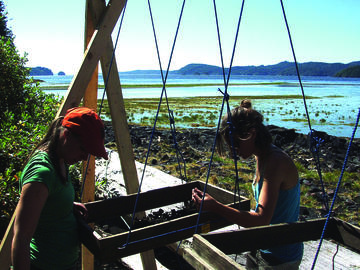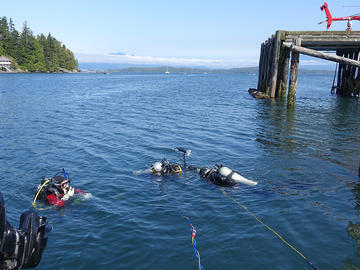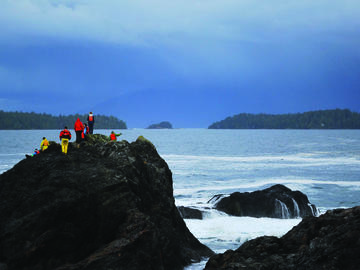April 12, 2022
UCalgary students conduct real-world ocean research at unique West Coast facility

The University of Calgary is on the land-locked Prairies but for 50 years it has provided a direct route for students to do cutting-edge research in the Pacific Ocean.
UCalgary is one of the founding universities of the Bamfield Marine Sciences Centre (BMSC), a world-class research and teaching station located on the outer west coast of Vancouver Island.
"The BMSC’s very nature as a collaborative hub means it hosts students from all different backgrounds and areas, a huge diverse group that can work together in this one area,” says Dr. Sean Rogers, PhD, the first UCalgary director of the BMSC in the station’s history.
“The real power of the education the students get is that it’s grounded in experience,” says Rogers, professor of ecology and evolutionary biology in the Department of Biological Sciences in the Faculty of Science.
The BMSC is a shared ocean campus of the Western Canadian Universities Marine Sciences Society, whose members include the universities of Calgary, Victoria, British Columbia, Simon Fraser and Alberta.
Located within the traditional territory of Huu-ay-aht First Nations, the BMSC provides ocean access in Barkley Sound to some of the richest marine biodiversity in the world.
Anna Smith
With the ocean at its doorstep and more than 3,000 square metres of fresh seawater laboratory space for living labs, there are no comparable facilities in Western Canada.
Canada has the longest coastline in the world and the country’s borders touch three oceans, Rogers says. “Those three oceans provide a lot of the food we eat and the oxygen we breathe.”
“The ocean weather, as we’re increasingly seeing especially over the last few years, impacts all Canadians,” he adds, referring to climate change, a warming ocean and recent devastating floods and wildfires in Western Canada.
UCalgary graduate and undergraduate students who do research at the Bamfield Marine Sciences Centre are trained to be leaders in the scientific disciplines aimed at finding solutions for managing changing ocean environments and conserving marine diversity, Rogers says.
Students who participate in the BMSC’s summer field program typically are studying biology, oceanography, geography, historical archeology, environmental law and other disciplines.
In addition, the BMSC’s award-winning K-12 field trip program provides younger students — including on average about 800 each year from Calgary alone — with multi-day, immersive STEM educational experiences in nature.
“A lot of these students are seeing the ocean for the very first time,” Rogers says.
You can teach about the ocean in a book. But until you’re out there, that’s when you get these ‘Ah ha!’ moments about what it means.
Along with doing marine sciences research, UCalgary students learn the skills needed to make good decisions and use sound judgment in the ocean environment.
“They’re taught how to work together in order to get the data they need to answer the scientific questions they have,” Rogers says.
“We have an incredible record of undergraduate students publishing their data in scientific journals,” he notes.
For example, since 2016, students attending the BMSC have collected DNA from more than 1,500 organisms representing local biodiversity. Some of these specimens were new contributions to the international DNA Barcode of Life reference library.

Marie Fournier
Two boats pivotal to student learning need replacing
A highlight of the BMSC is that students who have their pleasure craft operating certificate can pilot the facility’s small fleet of aluminum boats, called “Copes.” They learn to read an ocean chart of the area, navigate within a safe boundary, and use radios to communicate with each other across their boats and with the Bamfield station.
“They tell us time and time again that the ability to go out and collect the data on their own is something that you just can’t replicate anywhere else,” Rogers says.
Andreea Danasel, who did research at the BMSC as part of her BSc in Ecology, says, “I learned so much by being there in person and watching ecosystems at work than just learning about it in a 400-person lecture hall.
“I spent the best days in the Copes vessels, following like a duck behind my other classmates in Copes, on our way to uninhabited islands and plotting out transects along the inter-tidal zone.”
The five 14-foot Copes boats in the BMSC’s fleet are the workhorses of the marine environment for each class of 24 students in the summer field program, Rogers says.
Rugged, stable and with a reliable outboard motor, the Copes make more than 1,500 educational trips a year and are carefully maintained.
However, two of the vessels are now more than 30 years old and need to be retired, Rogers says. The BMSC, a not-for-profit organization that runs a tight ship financially, is looking at $16,000 each to replace the Copes, including their outboard motors.
With University of Calgary Giving Day taking place through to April 21, and the BMSC celebrating its 50th anniversary, Rogers encourages a donor or group of donors to help keep the station “shipshape.”
“With their gift, we can purchase two new Copes and enable the BMSC to provide life-changing exploration and discovery for students in these coastal environments.”
This Giving Day, make an impact with your gift by providing our students with life-changing experiential learning opportunities.












